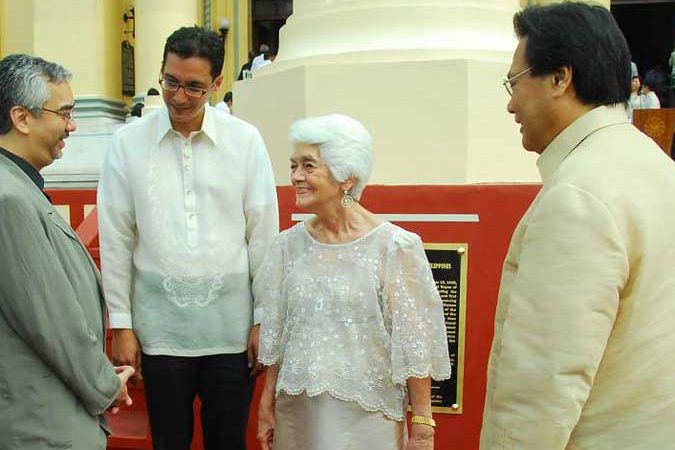Activist daughter of Manuel Quezon, ‘Nini’ Quezon Avanceña, passes at age 100

ZENEIDA “Nini” Quezon Avanceña, the sole surviving child of the second President of the Philippines and the first President of the Commonwealth of the Philippines died on July 12, 2021 — a full month after Independence Day celebrations on June 12. She turned 100 years old on April 9, mere months before her death.
Her passing was announced by one of her nine children, Ricky Avanceña, who said, “Mom passed peacefully as her children surrounded her, reading psalms from the bible and praying the rosary. An agent of light, of all things good and just, promoter and advocate of human rights, equality, social justice, land reform and freedom from oppression and poverty, has passed on to eternity.”
Mrs. Avanceña was born to then-Senate President Manuel L. Quezon and his wife and cousin, Aurora Aragon Quezon in 1921. Her father was the first president of that newly created body, and he went on to become president of the Philippine Commonwealth in 1935, a precursor to the independent Republic of the Philippines. Her mother, meanwhile, was the first First Lady to be known as such, the title having been unused prior to the Quezon administration. With the coming of the Second World War, the Quezon family lived in exile in the United States in 1942, her father dying in 1944.
Her mother returned to the Philippines with the rest of the family: older sister Maria Aurora (Baby), and younger brother Manuel Lucio (Nonong) and lived in the city that bore their name, a city spearheaded by their father, in an effort to create a new national capital. Her mother famously declined a pension from the Philippine government, and was known for her philanthropy. On April 28, 1949, Mrs. Quezon was assassinated by the Huks on her way to open the Quezon Memorial Hospital in her husband’s hometown of Baler. Traveling, and killed alongside her was her daughter Baby, and Nini’s husband Felipe Buencamino. Quezon City mayor Ponciano Bernardo and retired Armed Forces Chief of Staff Maj. Gen. Rafael Jalandoni, sharing the family’s car, were also killed. Nini narrowly escaped the same fate, having stayed home due to her pregnancy with her second child. She went on to marry for a second time, to Alberto Avanceña, a son of Chief Justice Ramon Avanceña, who had sworn her father into office.
Nini Quezon Avanceña, along with her great-nephew Manuel L. Quezon III, have been devoted to preserving their family’s legacy in history. Mrs. Avanceña was present when her mother’s remains were reinterred in the Quezon Memorial Circle in 2005.
Despite of, or because of, her background, Nini Quezon Avanceña devoted her very long life to various causes: these included the Philippine Red Cross, the Concerned Women of the Philippines, Movement Against the PCO (MAPCO), and was named to Corazon Cojuangco Aquino’s Presidential Human Rights Committee in 1986.
During the Martial Law years, Mrs. Quezon-Avanceña founded the Concerned Women of the Philippines together with Maring Feria, Bing Escoda Roxas, Saling Boncan and Charo Moran, among others, to show their opposition to dictator Ferdinand R. Marcos’ rule. Her political activism saw her joining Kaakbay, or the Kilusan sa Kapangyarihan at Karapatan ng Bayan, which advocated non-violent activism.
As a 2005 Newsbreak article by Action for Economic Reforms’ Filomeno S. Sta. Ana III explained, “Although the communists were responsible for the death of her loved ones, she later embraced just causes for which communists bore the brunt of the struggle. She reached out to tenants in her province, encouraged them to organize, and gave them land to till.
“She plunged herself into many causes — human rights, press freedom, release of political prisoners, removal of US military bases, nuclear disarmament, debt cancellation, etc. She was at the forefront of the open struggle to oust the Marcos dictatorship. She was at the frontlines during the EDSA I people power that overthrew Ferdinand Marcos and during the EDSA II mobilization that forced Joseph Estrada to step down.
“The positions she takes are consistently progressive, if not radical. But she always acts with grace and serenity.”
Former Presidential Spokesperson Edwin Lacierda said in a tweet: “A light has dimmed once more, the country orphaned by her passing. A pillar of strength during the dark days of martial law. She never wavered when the country needed a voice and spoke by marching with the youth, despite her age. Thank you Nini for your service to our nation.”
In a Facebook post, the National Museum of the Philippines expressed “its deep condolences to the Quezon-Avanceña family. “Known as ‘Tita Nini’ to all, she was very well loved and respected, and will be missed by a great many people — relations, friends, associates and admirers — throughout the Philippines and around the world, as well as here in this institution.”
Mrs. Avanceña is survived by nine children.



